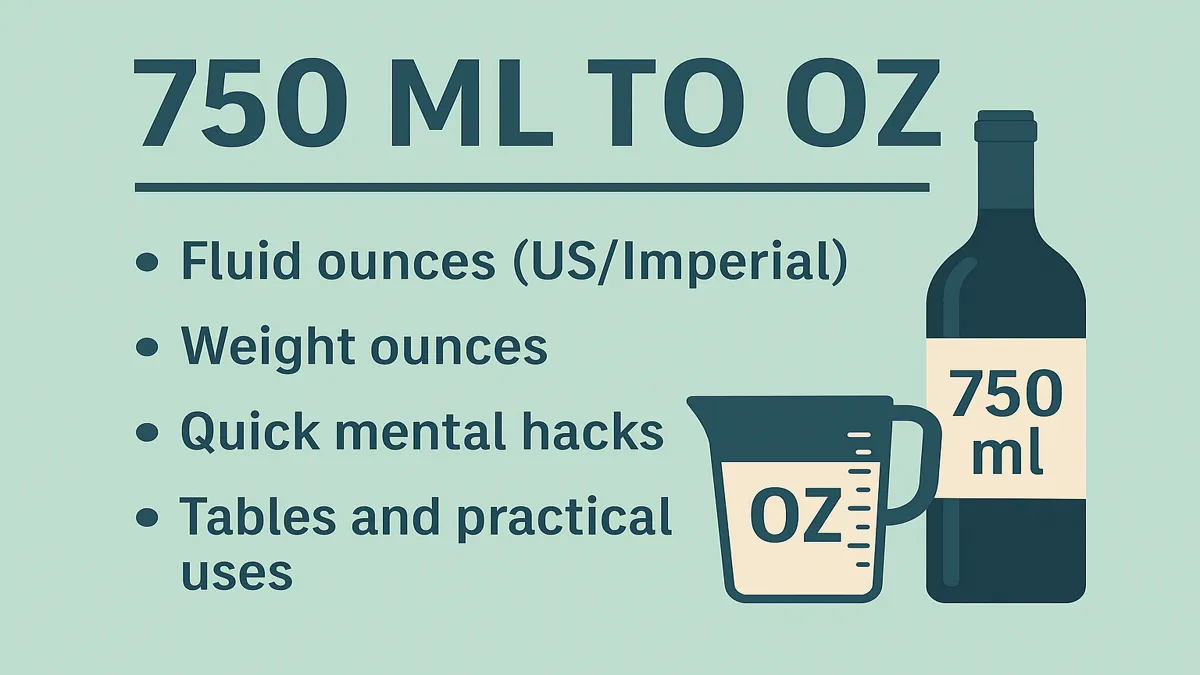When you type “750 ml to oz” into a search bar, your goal is clear: you want to know exactly how many ounces are in 750 milliliters, without unnecessary confusion. The direct answer is that 750 milliliters equals 25.36 US fluid ounces, or 26.40 Imperial fluid ounces if you’re using the UK measurement system. Within the first 100 words, your question is answered. But understanding why these numbers differ—and when to use each—is essential for cooks, bartenders, travelers, and anyone working across metric and customary systems. This guide breaks down every layer of the conversion: the math, the meaning, the common mistakes, and the practical implications of measuring by ounces versus milliliters.
💧 Convert 750 ml to Ounces (US / Imperial)
Accurately switch between milliliters and fluid ounces — perfect for recipes, bottles, and beverages.
| Milliliters (ml) | US Fluid Ounces | Imperial Fluid Ounces |
|---|---|---|
| 250 | 8.45 | 8.80 |
| 500 | 16.91 | 17.60 |
| 750 | 25.36 | 26.40 |
| 1000 | 33.81 | 35.20 |
Quick Hack: Approximate 1 oz ≈ 30 ml — good enough for mental math when cooking or pouring drinks.
Understanding the Basics: What Are Milliliters and Ounces?
A milliliter (ml) is a unit of volume in the metric system, equal to one-thousandth of a liter. It’s used globally to measure liquids in food, medicine, and science. An ounce (oz), however, can mean two different things: a fluid ounce, which measures volume, or a weight ounce, which measures mass. The dual meaning often leads to confusion. When converting 750 ml to oz, you must first decide whether you mean fluid ounces (volume) or ounces by weight (mass).
Key Points to Remember
• Fluid ounces (fl oz) measure volume.
• Ounces by weight (oz) measure mass.
• The two are not interchangeable.
As one culinary instructor once said, “A fluid ounce fills a space; a weight ounce tips a scale.” That distinction matters more than most people realize.
The Quick Answer: 750 ml to oz Conversion
Here’s the straightforward conversion you came for:
| Measurement Type | Equivalent in Ounces | Rounded Value |
|---|---|---|
| US Fluid Ounces | 25.3605170264 fl oz | 25.36 fl oz |
| UK (Imperial) Fluid Ounces | 26.3963097959 fl oz | 26.40 fl oz |
| Weight Ounces (Water Equivalent) | 26.4554714622 oz | 26.46 oz |
So, 750 ml equals about 25.36 US fluid ounces, which is the measure most people in the United States use when referring to drinks, recipes, or household liquids.
⚖️ Milliliters to Weight Ounces Converter
Estimate the weight in ounces of common liquids like water, milk, oil and alcohol for kitchen accuracy.
| Liquid | 750 ml ≈ Weight Ounces | Typical Use |
|---|---|---|
| Water | 26.46 oz | Hydration / Cooking |
| Milk | 27.25 oz | Baking / Smoothies |
| Olive Oil | 24.35 oz | Dressings / Frying |
| Alcohol | 20.86 oz | Mixology / Beverages |
Tip: 750 ml ≈ 25 fluid oz (US) ≈ 26 oz by weight for water — handy for quick kitchen math.
Why the Numbers Differ: US vs. UK Fluid Ounces
The discrepancy between 25.36 and 26.40 arises because the US fluid ounce and UK fluid ounce are defined differently.
- 1 US fluid ounce = 29.5735295625 milliliters
- 1 UK (Imperial) fluid ounce = 28.4130625 milliliters
The UK fluid ounce is smaller, so when converting 750 ml, you get a slightly larger number of ounces. Both systems are correct—just used in different regions.
As one measurement historian joked, “Two nations divided by a common ounce.”
Step-by-Step Conversion: How 750 ml Becomes 25.36 oz
Let’s go through the math to make it clear:
Formula:
US fl oz=ml29.5735295625\text{US fl oz} = \frac{\text{ml}}{29.5735295625}US fl oz=29.5735295625ml
Calculation:
750÷29.5735295625=25.3605170264 fl oz750 \div 29.5735295625 = 25.3605170264 \text{ fl oz}750÷29.5735295625=25.3605170264 fl oz
Rounded: 25.36 fl oz (US)
If using the UK system:
750÷28.4130625=26.3963097959 fl oz (UK)750 \div 28.4130625 = 26.3963097959 \text{ fl oz (UK)}750÷28.4130625=26.3963097959 fl oz (UK)
Rounded: 26.40 fl oz (UK)
For weight ounces (for water, since 1 ml ≈ 1 gram):
750÷28.349523125=26.4554714622 oz750 \div 28.349523125 = 26.4554714622 \text{ oz}750÷28.349523125=26.4554714622 oz
Rounded: 26.46 oz (weight)
How to Convert in Your Head
If you don’t have a calculator handy, use these mental shortcuts:
• For US fluid ounces: divide milliliters by 30 (since 1 fl oz ≈ 30 ml).
Example: 750 ÷ 30 = 25 (close to 25.36).
• For UK fluid ounces: divide milliliters by 28.4.
Example: 750 ÷ 28.4 ≈ 26.4.
This rule of thumb gives you an answer accurate enough for cooking, travel, or bar work.
The Context: Why 750 ml Is a Common Volume
The 750 ml bottle is the global standard for wine and spirits. Historically, it became the norm because it neatly converts to 25.36 US fluid ounces or five 5-ounce glasses of wine. In bartending, this standardization helps with consistency and pricing.
Example Uses
• Wine: 750 ml = about five 5-oz pours.
• Liquor: 750 ml = about 16 standard 1.5-oz shots.
• Cooking: 750 ml = about 3.17 US cups (since 1 cup = 236.588 ml).
As one sommelier once put it, “A 75-0 ml bottle is the language of hospitality—big enough to share, small enough to finish.”
750 ml to oz in Cooking and Baking
Cooking conversions can make or break a recipe. For liquid ingredients, volume (ml to fl oz) matters more than weight.
- 750 ml = 3.17 US cups
- 1 cup = 8 fl oz, so 3.17 × 8 = 25.36 fl oz
If you’re baking, always check whether the recipe measures in weight ounces or fluid ounces, especially for liquids like oil or honey. Liquids have different densities, meaning 750 ml of syrup will weigh more than 750 ml of water.
Quick Cooking Reference
• 750 ml of milk ≈ 25.36 fl oz
• 750 ml of olive oil ≈ 26.5 fl oz (due to density differences)
• 750 ml of syrup ≈ 27 fl oz (heavier density)
As a pastry chef famously said, “Precision is kindness to your future self.”
750 ml to oz for Bartenders and Hosts
A standard shot in the US is 1.5 oz. So, a 750 ml bottle yields approximately:
25.36÷1.5=16.9 shots25.36 \div 1.5 = 16.9 \text{ shots}25.36÷1.5=16.9 shots
That’s roughly 17 shots per bottle.
Practical Bar Reference
• 1 bottle (750 ml) = 17 shots (1.5 oz each)
• 1 bottle = 12 drinks (if each uses 2 oz of liquor)
• 2 bottles = 34 shots or 25 drinks
This consistency makes event planning easier. If hosting 10 guests, two 750 ml bottles generally suffice for cocktails.
750 ml in Other Measurement Units
Here’s a quick breakdown for practical conversions:
| Measurement Unit | Equivalent of 750 ml |
|---|---|
| US Fluid Ounces | 25.36 fl oz |
| UK Fluid Ounces | 26.40 fl oz |
| US Cups | 3.17 cups |
| US Tablespoons | 50.72 tbsp |
| US Teaspoons | 152.16 tsp |
| Grams (Water) | 750 g |
| Pounds (Water) | 1.65 lbs |
Real-World Scenarios Where “750 ml to oz” Matters
1. Wine and Beverage Industry
Understanding conversions helps bartenders and distributors manage stock. 25.36 ounces per bottle makes portion control straightforward and cost-efficient.
2. Cooking and Home Use
Cooks converting European recipes often need to translate milliliters into ounces or cups. Knowing 750 ml = 25.36 oz avoids waste and ensures accuracy.
3. Travel and Luggage Restrictions
Airline limits often use milliliters (100 ml max per container). Understanding 750 ml ≈ 25 oz helps travelers gauge whether bottles must go in checked bags.
4. Science and Education
Students converting between metric and imperial systems often practice with standard numbers like 750 ml, because it falls neatly between everyday scales—larger than a cup, smaller than a liter.
Common Mistakes in Conversion
• Mixing up weight and volume: Remember, fluid ounces measure volume; ounces measure mass.
• Using 30 ml = 1 oz as exact: This shortcut introduces a 1.4% error. Fine for cooking, not for lab work.
• Ignoring rounding precision: Small rounding differences compound in batch calculations.
As one chemist observed, “A single decimal misplaced can turn a recipe into an experiment—and not the fun kind.”
Density and Temperature: The Hidden Factors
Conversion assumes room temperature and water-like density. Liquids expand with heat and contract with cold. For alcohol or oil, density shifts mean a slightly different ounce equivalent. For example:
• Ethanol density ≈ 0.789 g/ml, so 750 ml ethanol weighs about 592 g, or 20.9 oz by weight.
• Honey density ≈ 1.42 g/ml, so 750 ml weighs about 1,065 g, or 37.6 oz by weight.
Therefore, volume-to-weight conversions depend on density, not just unit conversion.
Conversion Formula Summary
To keep handy for future reference:
• ml → US fl oz: multiply by 0.0338140227
• ml → UK fl oz: multiply by 0.0351950797
• ml → oz (weight for water): multiply by 0.0352739619
Example (US fl oz):
750×0.0338140227=25.36 fl oz750 × 0.0338140227 = 25.36 \text{ fl oz}750×0.0338140227=25.36 fl oz
Everyday Conversion Shortcuts
When you just need a quick estimate:
• 100 ml ≈ 3.4 fl oz
• 250 ml ≈ 8.45 fl oz (1 cup)
• 500 ml ≈ 16.9 fl oz (half-liter bottle)
• 750 ml ≈ 25.36 fl oz
• 1000 ml ≈ 33.8 fl oz (1 liter)
Fun Fact: Why 750 ml Became the Wine Standard
In the 19th century, glassmakers discovered that 750 ml was the optimal size for both bottling and transport. It also roughly matched six standard servings and 1/5 of a US gallon, making trade and customs simpler. Over time, this became the international benchmark.
Conversion Recap Table
| Type of Conversion | Formula | Result (for 750 ml) | Rounded |
|---|---|---|---|
| US Fluid Ounces | ml ÷ 29.5735 | 25.3605 fl oz | 25.36 fl oz |
| UK Fluid Ounces | ml ÷ 28.4131 | 26.3963 fl oz | 26.40 fl oz |
| US Cups | ml ÷ 236.588 | 3.1700 cups | 3.17 cups |
| Weight Ounces (Water) | ml ÷ 28.3495 | 26.4555 oz | 26.46 oz |
The Broader Importance of Unit Literacy
Understanding conversions like 750 ml to oz is part of measurement literacy—the ability to interpret data across systems. In a globalized world, recipes, formulas, and products move across borders daily. Clarity about units prevents waste, saves time, and fosters consistency.
As an educational advocate once wrote, “Math lives in the kitchen, the lab, and the glass—it’s the quiet precision behind every good result.”
Conclusion
Converting 750 ml to oz seems simple, but it opens a window into how measurement systems shape everyday life. Whether you’re pouring wine, mixing cocktails, or scaling recipes, understanding that 750 ml equals 25.36 US fluid ounces (or 26.40 UK fl oz) ensures precision and confidence. Remember, conversions are more than numbers—they’re a bridge between systems, a language of accuracy that connects the scientific with the personal. And in that connection, every decimal point counts.
Frequently Asked Questions
Q1: How many ounces are in 750 ml of wine?
About 25.36 US fluid ounces, or five 5-oz glasses.
Q2: How many shots are in a 750 ml bottle of liquor?
Roughly 17 standard 1.5-oz shots.
Q3: Is 750 ml the same as a fifth?
Yes, a “fifth” of a gallon (used in the US) equals 750 ml.
Q4: How many cups is 750 ml?
About 3.17 US cups.
Q5: How much does 750 ml of water weigh?
Approximately 750 grams or 26.46 ounces by weight.











